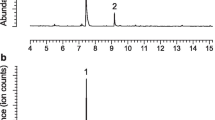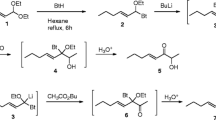Abstract
An increasing body of evidence suggests that the volatile pheromones of cerambycid beetles are much more diverse in structure than previously hypothesized. Here, we describe the identification, synthesis, and field testing of (2E,6Z,9Z)-2,6,9-pentadecatrienal as a male-produced aggregation-sex pheromone of the cerambycid Elaphidion mucronatum (Say) (subfamily Cerambycinae, tribe Elaphidiini). This novel structure is unlike any previously described cerambycid pheromone, and in field bioassays attracted only this species. Males produced about 9 μg of pheromone per 24 h period, and, in field trials, lures loaded with 10, 25, and 100 mg of synthetic pheromone attracted beetles of both sexes, whereas lures loaded with 1 mg of pheromone or less were not significantly attractive. Other typical cerambycine pheromones such as 3-hydroxy-2-hexanone, syn-2,3-hexanediol, and anti-2,3-hexanediol were not attractive to E. mucronatum, and when combined with (2E,6Z,9Z)-2,6,9-pentadecatrienal, the former two compounds appeared to inhibit attraction. Unexpectedly, adults of the cerambycine Xylotrechus colonus (F.) were attracted in significant numbers to a blend of 3-hydroxyhexan-2-one and (2E,6Z,9Z)-2,6,9-pentadecatrienal, even though there is no evidence that this species produces the latter compound. From timed pheromone trap catches, adults of E. mucronatum were determined to be active from dusk until shortly after midnight.



Similar content being viewed by others
References
Allison JD, Borden JH, Seybold SJ (2004) A review of the chemical ecology of the Cerambycidae (Coleoptera). Chemoecology 14:123–150
Álvarez G, Gallego D, Hall DR, Jactel H, Pajares JA (2016) Combining pheromone and kairomones for effective trapping of the pine sawyer beetle Monochamus galloprovincialis. J Appl Entomol 140:58–71
Champlain AB, Kirk HB (1926) Bait pan insects. Entomol News 37:288–291
Corey EJ, Wright SW (1984) A simple process for the purification of arachidonic acid. Tet Lett 26:2729–2730
Coyle DR, Brissey CL, Gandhi KJK (2015) Species characterization and responses of subcortical insects to trap-logs and ethanol in a hardwood biomass plantation. Ag For Entomol 17:258–269
Diesel NM, Zou Y, Johnson TD, Diesel DA, Millar JG, Mongold-Diers JA, Hanks LM (2017) The rare north American cerambycid beetle Dryobius sexnotatus shares a novel pyrrole pheromone component with species in Asia and South America. J Chem Ecol 43:739–744
Duffy EAJ (1953) A monograph of the immature stages of British and imported timber beetles (Cerambycidae), Brit Mus (Nat. Hist.), London
Dunn JP, Potter DA (1991) Synergistic effects of oak volatiles with ethanol in the capture of saprophagous wood borers. J Entomol Sci 26:425–429
Eyre D, Haack RA (2017) Invasive cerambycid pests and biosecurity measures. In: Wang Q (ed) Cerambycidae of the world: biology and pest management. CRC Press/Taylor & Francis, Boca Raton, pp 563–607
Flock S, Lundquist M, Skattebǿl L (1999) Syntheses of some polyunsaturated sulfur- and oxygen-containing fatty acids related to eicosapentaenoic and docosapentaenoic acids. Acta Chem Scand 53:436–445
Frost SW, Dietrich H (1929) Coleoptera taken from bait-traps. Ann Entomol Soc Am 22:427–436
Graham EE, Mitchell RF, Reagel PF, Barbour JD, Millar JG, Hanks LM (2010) Treating panel traps with a fluoropolymer enhances their efficiency in capturing cerambycid beetles. J Econ Entomol 103:641–647
Handley K, Hough-Goldstein J, Hanks LM, Millar JG, D'Amico V (2015) Species richness and phenology of cerambycid beetles in urban forest fragments of northern Delaware. Ann Entomol Soc Am 108:251–262
Hanks LM (1999) Influence of the larval host plant on reproductive strategies of cerambycid beetles. Annu Rev Entomol 44:483–505
Hanks LM, Millar JG (2013) Field bioassays of cerambycid pheromones reveal widespread parsimony of pheromone structures, enhancement by host plant volatiles, and antagonism by components from heterospecifics. Chemoecology 23:21–44
Hanks LM, Millar JG (2016) Sex and aggregation pheromones of cerambycid beetles: basic science and practical applications. J Chem Ecol 42:631–654
Hanks LM, Reagel PF, Mitchell RF, Wong JCH, Meier LR, Silliman CA, Graham EE, Striman BL, Robinson KP, Mongold-Diers JA, Millar JG (2014) Seasonal phenology of the cerambycid beetles of east-central Illinois. Ann Entomol Soc Am 107:211–226
Hoshino K, Nakaba S, Inoue H, Iwabuchi K (2015) Structure and development of male pheromone gland of longicorn beetles and its phylogenetic relationships within the tribe Clytini. J Exp Zool Part B: Mol Dev Evol 324:68–76
Lacey ES, Ginzel MD, Millar JG, Hanks LM (2004) Male-produced aggregation pheromone of the cerambycid beetle Neoclytus acuminatus acuminatus. J Chem Ecol 30:1493–1507
Lacey ES, Moreira JA, Millar JG, Ray AM, Hanks LM (2007) Male-produced aggregation pheromone of the cerambycid beetle Neoclytus mucronatus mucronatus. Entomol Exp Appl 122:171–179
Lingafelter SW (2007) Illustrated key to the longhorned wood-boring beetles of the eastern United States. Special Publication No. 3. Coleopterists Society, North Potomac
Linsley EG (1963) The Cerambycidae of North America, Part IV Taxonomy and classification of the subfamily Cerambycinae, tribes Elaphidionini through Rhinotragini University of California Publications in Entomology 21 University of California Press, Berkeley
MacRae TC, Rice ME (2007) Biological and distributional observations on north American Cerambycidae (Coleoptera). Coleopt Bull 61:227–263
Millar JG, Hanks LM (2017) Chemical ecology of cerambycids. In: Wang Q (ed) Cerambycidae of the world: biology and pest management. CRC press. Taylor & Francis, Boca Raton, pp 167–202
Millar JG, Hanks LM, Mitchell RF, Mongold-Diers JA, Zou Y, Bográn CE, Dodds KJ, Fierke MK, Ginzel MD, Johnson CW, Meeker JR, Poland TM, Ragenovich I (2017) Identifying possible pheromones of cerambycid beetles by field testing known pheromone components in four widely separated regions of the United States. J Econ Entomol (in press)
Miller DR, Crowe CM, Mayo PD, Silk PJ, Sweeney JD (2015) Responses of Cerambycidae and other insects to traps baited with ethanol, 2,3-hexanediol, and 3,2-hydroxyketone lures in north-central Georgia. J Econ Entomol 108:2354–2365
Mitchell RF, Millar JG, Hanks LM (2013) Blends of (R)-3-hydroxyhexan-2-one and alkan-2-ones identified as potential pheromones produced by three species of cerambycid beetles. Chemoecology 23:121–127
Mitchell RF, Reagel PF, Wong JCH, Meier LR, Silva WD, Mongold-Diers J, Millar JG, Hanks LM (2015) Cerambycid beetle species with similar pheromones are segregated by phenology and minor pheromone components. J Chem Ecol 41:431–440
Moustakis CA, Viala J, Capdevila J, Falck JR (1985) Total synthesis of cytochrome P450 epoxygenase metabolites 5(R),6(S)-, 5(S),6(R)-, and 14(R),15(S)-epoxyeicosatrienoic acid (EET) and hydration products 5(R),6(R)- and 14(R),15(R)-dihydroxyeicosatrienoic acid (DHET). J Am Chem Soc 107:5283–5285
Mustafa HH, Baird MS, Juma’a R, Tverezovskiy VV (2014) A nine-carbon homologating system for skip-conjugated polyenes. Chem Phys Lipids 183:34–42
Ray AM, Lacey ES, Hanks LM (2006) Predicted taxonomic patterns in pheromone production by longhorned beetles. Naturwissenschaften 93:543–550
Ray AM, Millar JG, McElfresh JS, Swift IP, Barbour JD, Hanks LM (2009) Male-produced aggregation pheromone of the cerambycid beetle Rosalia funebris. J Chem Ecol 35:96–103
SAS Institute (2011) SAS/STAT 9. User's Guide. SAS Institute Inc., Cary, NC, p 3
Silva WD, Millar JG, Hanks LM, Bento JMS (2016a) 10-Methyldodecanal, a novel attractant pheromone produced by males of the south American cerambycid beetle Eburodacrys vittata. PLoS One 11:e0160727
Silva WD, Millar JG, Hanks LM, Bento JMS (2016b) (6E,8Z)-6,8-Pentadecadienal, a novel attractant pheromone produced by males of the cerambycid beetles Chlorida festiva and Chlorida costata. J Chem Ecol 42:1082–1085
Silva WD, Zou Y, Bento JMS, Hanks LM, Millar JG (2017) Aggregation-sex pheromones and likely pheromones of 11 South American cerambycid beetles, and partitioning of pheromone channels. Frontiers Ecol Evol 5 article 101 https://doi.org/10.3389/fevo.2017.00101
Vali SJ, Sheng HY, Y-H J (2003) An efficient method for the purification of arachidonic acid from fungal single-cell oil (ARASCO). J Am Oil Chem Soc 80:725–730
Waters DJ (1981) Life history of Neoclytus acuminatus with notes on other cerambycids associated with dead or dying deciduous trees. Auburn University, Auburn, AL, M. Sc. thesis
Wong JCH, Meier LR, Zou Y, Mongold-Diers J, Hanks LM (2017a) Evaluation of methods used in testing attraction of cerambycid beetles to pheromone-baited traps. J Econ Entomol 110:2269–2274
Wong JCH, Zou Q, Millar JG, Hanks LM (2017b) Attraction of adult cerambycid beetles to their aggregation-sex pheromones is influenced by volatiles from host plants of their larvae. Environ Entomol 46:649–653
Zhang A, Oliver JE, Aldrich JR, Wang B. Mastro VC (2002) Stimulatory beetle volatiles for the Asian longhorned beetle, Anoplophora glabripennis (Motschulsky). Zeit Naturforsch C 57:553–558
Zou Y, Millar JG, Blackwood JS, Duzor RV, Hanks LM, Mongold-Diers JA, Wong JCH, Ray AM (2015) (2S,4E)-2-hydroxyoct-4-en-3-one, a male-produced attractant pheromone of the cerambycid beetle Tylonotus bimaculatus. J Chem Ecol 41:670–677
Zou Y, Rutledge CE, Nakamuta K, Maier CT, Hanks LM, Richards AB, Lacey ES, Millar JG (2016) Identification of a pheromone component and a critical synergist for the invasive beetle Callidiellum rufipenne (Coleoptera: Cerambycidae). Environ Entomol 45:216–222
Acknowledgements
We thank Kate Johnson for technical assistance in the field, and Steve Buck and James Ellis of the University of Illinois Committee on Natural Areas for access to field sites. JGM thanks Lars Skattebǿl (Dept. of Chemistry, University of Oslo) for the gift of a sample of (2E,6Z,9Z,12Z)-2,6,9,12-pentadecatetraenol. We appreciate funding support from The Alphawood Foundation of Chicago (to LMH) and from the USDA National Institute of Food and Agriculture (award # 2015-67013-23173 to LMH and JGM).
Author information
Authors and Affiliations
Corresponding author
Electronic Supplementary Material
ESM 1
(PDF 592 kb)
Rights and permissions
About this article
Cite this article
Millar, J.G., Mitchell, R.F., Meier, L.R. et al. (2E,6Z,9Z)-2,6,9-Pentadecatrienal as a Male-Produced Aggregation-Sex Pheromone of the Cerambycid Beetle Elaphidion mucronatum . J Chem Ecol 43, 1056–1065 (2017). https://doi.org/10.1007/s10886-017-0905-1
Received:
Revised:
Accepted:
Published:
Issue Date:
DOI: https://doi.org/10.1007/s10886-017-0905-1




